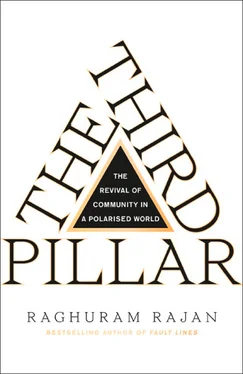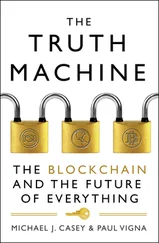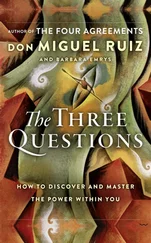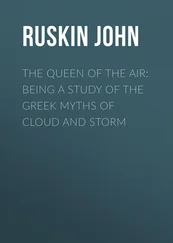1 ...6 7 8 10 11 12 ...30 THE VALUE OF COMMUNITY
It is easy to see why the community is so appealing. Apart from contributing to our sense of who we are, a richer range of transactions can be undertaken within the community than would be possible if everything had to be contractual and strictly enforced by the law. The record of what one does for the community continues to be visible in the community, and it does not vanish into an anonymous marketplace. This leads to greater pride, ownership, and responsibility. The community comes together to raise its young and to support its weak, elderly, and unlucky. Because of its proximity, and the degree of information it receives, the community can tailor help to the specific needs of the situation. It also recognises freeloaders far better than any distant government could and can shut down their benefits. As a result, given any quantity of available resources, it can offer a far-higher level of benefits to the truly needy. Communities therefore aid the individual, preventing them from drifting – untaught, unaided, and unanchored – in life.
The work of economic theorists like Oliver Hart, who won the Nobel Prize in Economics in 2016, offers a related explanation for the economic value of communities. The real world is plagued by the problem of incomplete contracts. We cannot fully anticipate what will happen in the future, and even if we can, we do not have the ability to prove who did what, and when, to the satisfaction of a court of law. We cannot thus write the full range of arm’s-length contracts that would be necessary to deal with all the problems that might arise in real life. For instance, to deal with the problem of stray cattle with explicit arm’s-length contracts, every rancher would have to contract with every other rancher on what ought to be done if his cattle strays, as well as on the necessary payments for services rendered. With little ability to verify when the cattle wondered off the ranch, or what the quality of their treatment was in the hands of the rancher who found them, lawsuits could proliferate. The system of implicit community responsibility and enforcement might be far more effective in protecting cattle and minimising transactions costs than using explicit contracts and the legal system. Communities thus can be more than the sum of individuals who compose them.
Finally, an important modern function of communities is to give the individual in large countries some political influence over the way they are governed, and thus a sense of control over their lives, as well as a sense of public responsibility. Well-structured countries decentralise a lot of decisions to local community government. To the extent that individuals can organise collective political action within the community more easily, it affords them a vehicle to affect issues on a national stage. The community then magnifies the power of the individual. We will return to the political role of the community later in the book.
DYSFUNCTIONAL COMMUNITIES
We have seen what functional communities do. Consider now a classic picture of a dysfunctional community and what it does not do. Dysfunctional communities in developed countries can be virtual war zones, with widespread drug addiction, crime, failing schools, and broken families. Who would expect significant public engagement if even leaving home is dangerous? This is why the Pilsen community we discussed in the Preface set about tackling crime as the first step in community revival. However, dysfunctional communities are present in even fairly safe areas around the world.
In the mid-1950s, social anthropologist Edward Banfield spent nearly a year studying a poor village in Southern Italy, to which he gave a fictitious name, Montegrano. The extent of underdevelopment of the village can be gauged by the fact that many of the inhabitants were illiterate and did not have toilets with running water. The village remained underdeveloped even in an Italy that was then undergoing a miraculous economic transformation, in part, as Banfield argues, because of ‘the inability of the villagers to act together for their common good’. 12Anyone who has been to dysfunctional communities around the world will recognise some of Montegrano in those communities.
The main occupation in Montegrano was agriculture, but with limited untilled land and small land holdings, it was unlikely that peasant families would prosper by staying in agriculture. Even so, the main path of upward mobility for children, education, was largely blocked. Only five grades of school were taught in the village, the schools were poorly equipped, teachers poorly paid, and attendance, both by students and teachers, was irregular. Moreover, ‘After finishing the fifth grade some students can barely read or write or do simple sums … According to a Montegrano school official, one-third of the [school] graduates are illiterate several years after graduation.’ 13Many children did not attend schools regularly, and some farm people sent their children to school willingly only so long as they were too young to work in the fields.
An engineer from Northern Italy, who was shocked at the lack of professionalism among teachers in Montegrano, perhaps best captured what was wrong: He noted that during the summer vacation, a teacher from more prosperous Northern Italy might hold informal classes, take children for walks into the country and explain a bit about nature, or even go on picnics. In contrast, teachers in Montegrano spent their summers ‘loafing in the piazza’, and did not speak to their students when they saw them. The teachers simply did not care if their students learned anything. 14
Apathy was evident elsewhere too. There were no organised voluntary charities in the village. An order of nuns from outside the village maintained an orphanage for little girls in a crumbling monastery, but even though girls from local families were at the orphanage, ‘none of the many half-employed stone masons has ever given a day’s work to its repair’. 15There was not enough food for the children, ‘but no peasant or land proprietor ha[d] ever given a young pig to the orphanage.’ 16
The nearest hospital was five hours away by car, and few villagers could afford the trip. There was no organised effort to bring a hospital nearby, despite villagers complaining for years about the lack of access to medical facilities. Stopgap measures to improve access to education and health care, such as rescheduling public bus timings to transport village children to schools elsewhere, or funding an ambulance to carry emergency cases from the area to the hospital, were simply not considered.
A functional community would have put pressure on the local government to improve public services, failing which volunteers would have gathered to undertake the task. While Montegrano had an elected mayor and council, decisions ‘even to buy an ashtray’ were taken by the prefect, a member of the civil service sitting in Potenza, the nearest large town. 17Similarly, the director of schools reported directly to Potenza, public works were not under the purview of local government, and the police were under the Ministry of Justice in Rome. Too few important decisions were taken locally, a problem we will discuss later in the book, but even so, villagers did not even try to influence them.
The problem in Montegrano, as Banfield argues, was the extreme distrust between villagers, their worry about losing relative social position if they helped someone else improve their lot, and their corrosive envy of those who did succeed. Given this attitude, anyone who undertook a public-spirited action felt they incurred the full costs of acting, would probably receive only a small part of the public benefits, and would feel diminished by the public benefits that went to others. As one teacher explained, not only was there little public spirit, but many people positively wanted to prevent others from getting ahead. 18Such public apathy explains why voluntary efforts to supply public services – for example, masons repairing the monastery – simply did not emerge.
Читать дальше












